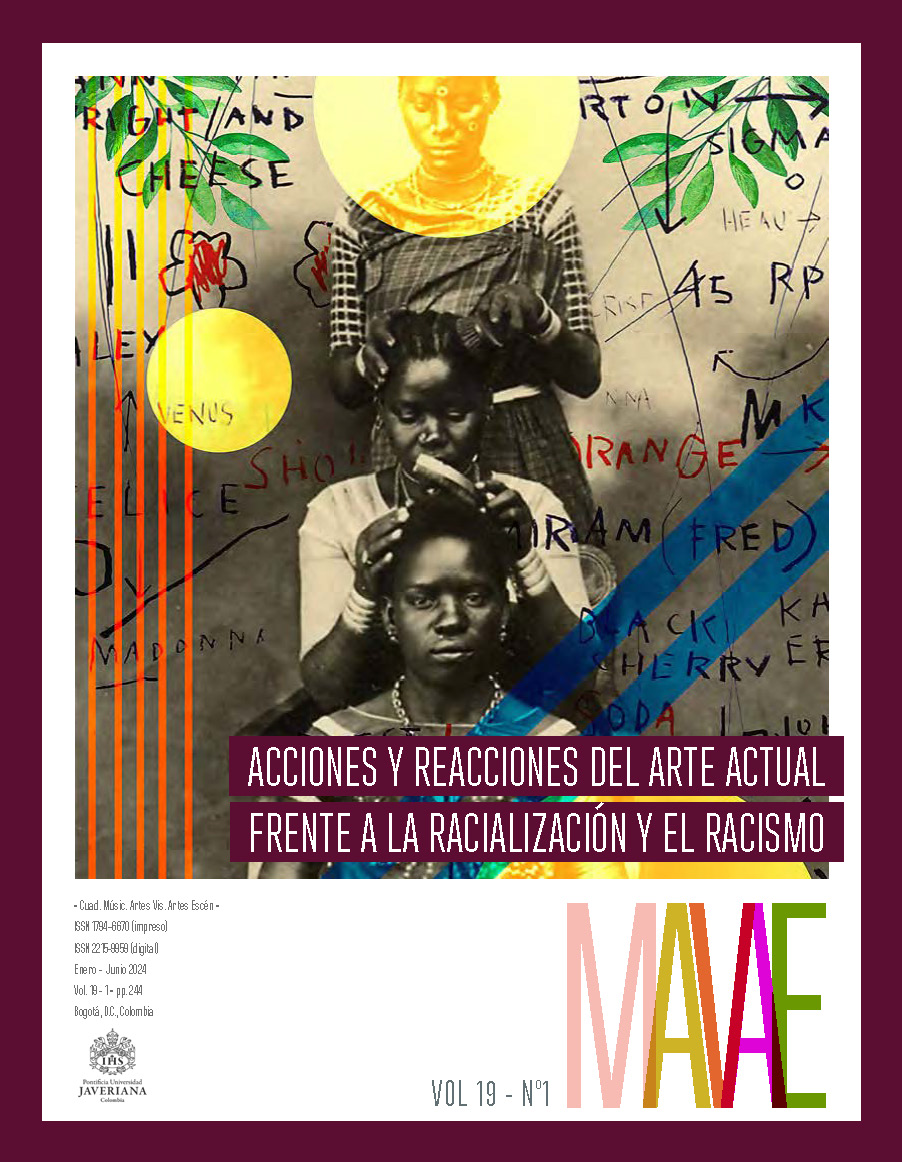Resumen
La fotografía pintoresca de tipos pretos y antropom.trica realizada en Brasil, al igual que en otros lugares de América a finales del siglo XIX, es analizada como un instrumento de dominio y expansi.n colonial, que sirvió para promover y perpetuar el modelo esclavista al intentar naturalizar el trabajo esclavo de la población negra, que durante más de tres siglos mantuvo la econom.a de los reinos. Para este propósito, se realiza un análisis del uso y las características del retrato en Occidente, en general, encontrando que los recursos formales y técnicos son los mismos, pero su rol social fue marcadamente diferente, aspecto que contribuyó a la exotización y deshumanización del cuerpo negro, características que han sobrevivido hasta nuestra época promoviendo el racismo en nuestra sociedad. En una segunda instancia, se analiza la obra de la artista Rosana Paulino, quien busca una reafirmación histórica de la violencia esclavista desde una perspectiva crítica y sensible, a través de la apropiación fotogrífica en la producción de obras de arte. Este procedimiento lo denomino segunda vida de la imagen, con la finalidad de resaltar la transformación política y formal que adquiere el archivo fotográfico desde el campo del arte. Asimismo, se busca examinar aspectos de la fotografía, como la ampliación, fragmentación, transferencia y reproducción, entre otros, que más allá de ser una serie de recursos formales se presentan como cuestiones teóricas y simbólicas en la producción de obras de arte en la actualidad.
Alencastro, Felipe de. 2008. “Vida privada e ordem privada no Império”.En História da vida privada no Brasil II, editado por Luiz Felipe de
Alencastro, 13-93. São Paulo: Companhia das letras.
Antonacci, Célia. 2014. “Parede da Memória”: Rosana Paulino. https://vimeo.com/111885499Barthes, Roland. 2006. La cámara lúcida.Madrid: Paidós.
Belting, Hasn. 2012. Antropología de la imagen. Madrid: Katz.
Benjamin, Walter. 2011. Breve historia de la fotografía. Madrid: Casimiro.
Benjamin, Walter. 2017. Walter Benjamin: Estética e sociologia da arte. São Paulo: Autêntica.
Berger, John. 2000. Modos de ver. Barcelona: Gustavo Gili.
Cáceres Gómez, Rina. 2001. Rutas de la esclavitud en África y América Latina. San Pedro: Universidad de Costa Rica.
Cunha, Maria Manuela Ligeti Carneiro da. 1988. “Olhar escravo, ser olhado”. En Escravos brasileiros do século XIX na fotografia de Christiano Jr.
São Paulo: Ex Libris.
Didi-Huberman, George. 2005. Venus rajada. Buenos Aires: Losada.
EGEAC - Cultura em Lisboa. 2023. “Atlântico Vermelho, de Rosana Paulino |Memória Futura”. https://www.youtube.com/watch?v=dGSL3gcOfd4
“En fotos: Esclavos de Brasil, entre la emancipación y la exclusión”.2013. BBC, 20 noviembre. https://www.bbc.com/mundo/video_fotos/2013/11/131119_galeria_esclavos_de_brasil_gl_bd
Encyclopedia Virginia. 2023. “Description of the Slave Ship ‘Brookes’”;chapter 6 of Liverpool and Slavery by “a Genuine ‘DickySam’” (1884)”. https://encyclopediavirginia.org/entries/description-of-the-slave-ship-brookes-chapter-6-of-liverpool-andslavery-by-a-genuine-dicky-sam-1884/
Ermakoff, George. 2004. O negro na fotografia brasileira do século XIX. Ríode Janeiro: G Ermakoff.
James E. Arsenault & Company. 2023. “With A Variant Slave Ship Brookes Engraving”. https://www.jamesarsenault.com/pages/books/4904/
robert-stokes/regulated-slave-trade-from-the-evidence-of-robertstokes-esq-given-before-the-select-committee-of?soldItem=true
Institute for the Public Understanding of the Past/Institute of Historical Research. 2007. “The Brookes - visualising the transatlantic
slave trade”. https://archives.history.ac.uk/1807commemorated/exhibitions/museums/brookes.html
Instituto Moreira Salles. 2020. Marc Ferrez: Território e imagen por Ynaê Santos Lopes. https://www.youtube.com/playlist?list=PLC90FSGUmLhRZBQvEArIHVMGbr_itZNzIIrmscher, Christoph. 2020. “Mr. Agassiz’s Saloon”. En To Make Their Own Way in the World: The Enduring Legacy of the Zealy Daguerreotypes, editado por Ilisa Barbash, Molly Rogers y Deborah Willis. Cambridge:
Harvard University Press.
La Habana Elegante. 2023. “La ronda”. http://www.habanaelegante.com/November_2015/Ronda.html
Leite, Marcelo Eduardo. 2011. “Typos de pretos: Escravos na fotografia de Christiano Jr”. Visualidades 9, n.º 1: 25-47. https://doi.org/10.5216/vis.v9i1.18368
Lévi-Strauss, Claude y George Charbonnier. 1971. Arte, lenguaje, etnología: Claude Lévi-Strauss entrevista con George Charbonnier.
Traducido por Francisco González Aramburu. México: Siglo XXI.
Mauad, Ana Maria. 2000. “As fronteiras da cor: Imagem e representação social na sociedade escravista imperial”. Locus: Revista de
História 6, n.º 2. https://periodicos.ufjf.br/index.php/locus/article/view/20515/10932
Quintella, Pollyana. 2020. “Rosana Paulino: Quando imagem vira corpo”.https://revistacontinente.com.br/edicoes/234/rosana-paulino
Queirós Mattoso, Katia M. 2008. “A opulência na provincia da Bahia”.En História da vida privada no Brasil II, editado por Luiz Felipe de
Alencastro. Saõ Paulo: Schwarcz.
Ribeiro, Leila María. 2019. “O olhar não é do branco, e sim do negro:Retrato fotográfico de escravo através da lente de christiano
junior, entre 1864 e 1866, da coleção Thereza Christina Maria”. Tesis pregrado. Pontifícia Universidade Católica.
Rodríguez Balanta, Beatriz Eugenia. 2012. “Especímenes antropométricos y curiosidades pintorescas: La orquestación
fotográfica del cuerpo ‘negro’ (Brasil circa 1865)”. Revista Ciencias de la Salud 10, n.º 2: 59-78. https://repository.urosario.
edu.co/server/api/core/bitstreams/d2c15a30-7fbc-4072-a821-ae7cad3b912a/content
Rosana Paulino. 2014. https://rosanapaulino.com.br/blog/projetos/
Rouillé, André. 2017. La fotografía entre documento y arte contemporáneo. México: Herder.
Velásquez Sánchez, Ximena. 2022. “Segunda vida: Fotografia vernáculana plástica contemporânea”. Tesis de doctorado. Universidad
Estadual de Campinas. https://repositorio.unicamp.br/Busca/Download?codigoArquivo=555076Videobrasil. 2023. “Das avós (2019), de Rosana
Paulino”. https://www.youtube.com/watch?v=9-V3n1cPnlI
Wade, Peter. 2021. “Racismos latinoamericanos desde una perspectiva global”. Nueva Sociedad 292: 25-41. https://www.cadtm.org/
Racismos-latinoamericanos-desde-una-perspectiva-global

Esta obra está bajo una licencia internacional Creative Commons Atribución 4.0.
Derechos de autor 2023 Ximena Velásquez Sánchez


